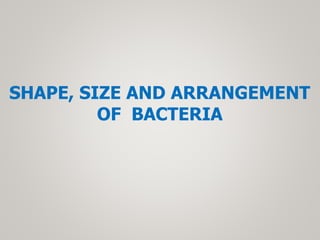
Shape-size-and-arrangement-of-bacteria
- 1. SHAPE, SIZE AND ARRANGEMENT OF BACTERIA
- 3. BASIC SHAPES 1. Coccus (pl. cocci)– round or spherical 2. Bacillus (pl. bacilli) – rod or cylindrical 3. Spirillum (pl. spirlli) – spiral
- 4. Cocci – Spherical or ovoid cells, e.g. Staphylococcus . Bacilli – Straight and cylindrical rods, e.g. Bacillus spp. long, thin filamentous form, e.g. Actinomycetes Spirillum – comma-shaped (vibrio), e.g. Vibrio, Campylobacter spiral-shaped, loosely coiled (spirochete), e.g. Spirochetes, elongated, tightly coiled (spirillum), e.g. Azospirillum spp) Pleomorphic – variable shape SHAPES OF BACTERIA
- 5. • Coccobacilli – cells in between round and rod shape • Vibrio – curved cell • Spirillum – spirilla, plural – rigid, wave-like shaped cell • Spirochete – Corkscrew shaped cells OTHER COMMON SHAPES
- 6. Bacteria are very small in size cocci are approx. 0.5 to 1.0 μm in diameter. rods range from 2 to 5 μm in length by 0.5 to 1.0 μm in width Spirochetes are longer (up to 20 μm) and narrower (0.1 to 1.0 μm) varies with the medium and growth phase usually smallest in the logarithmic phase of growth. SIZE OF BACTERIA
- 8. Bacteria compared to a white blood cell that is going to eat it Bacteria
- 10. CLEAN SKIN HAS ABOUT 20 MILLION BACTERIA PER SQUARE INCH
- 11. The surface area/volume ratio of a spherical bacteria of 1 µm in diameter is high (6:1) as compared to a spherical eukaryotic cell having a diameter of 20 µm (0.3:1). Consequently: • the intake of nutrients and removal of waste products is quick - the bacteria has high rate of growth and metabolism. • no circulatory mechanism for nutrients is needed - the cytoplasmic streaming is absent. SURFACE AREA/VOLUME RATIO
- 12. ARRANGEMENT OF BACTERIAL CELLS Cocci Diplococci - Cells divide in one plane and remain attached predominately in pairs, e.g. pneumococci. Streptococci - Cells divide in one plain and remain attached to form chains, e.g Streptococcus Tetracocci - Cells divide in two planes and forms groups of four cells. (also called as ‘tetrads’), e.g. Aerococcus. Sarcinae - Cells divide in three planes, in a regular pattern producing a cubodial arrangement of cells. Staphylococci - Cells divide in three planes, in an irregular pattern producing bunches of cocci,
- 13. Spherical is called coccus. Division along the same plane forms chains; 2 cocci together - Diplococcus 4 - 20 in chains - Streptococcus. Division along 2 different planes - Tetrads Division along 3 planes regularly - Sarcinae Division along 3 planes irregularly - Staphylococci
- 14. SMALL COCCI OCCURRING SINGLY OR IN
- 15. A tetrad appears as a square of four cocci (arrows)
- 16. COCCI ARRANGED IN CLUSTERS
- 17. BACI LLI Single Diplobacilli - in pairs Streptobacilli – in chains, e.g. Bacillus subtilis Trichomes - rod-shaped bacteria arranged in chains with a larger area of contact between adjacent cells, e.g. Beggiatoa spp. Palisade – the cells are lined side by side as match sticks, e.g. Mycobacterium tuberculosis. Chinese letter like – e.g., Corynebacterium spp. Filamentous – long, mycelium like branching, mono-nuclear, e.g. Actinomycetes Hyphae – long, branched, multinucleate filaments, e.g. Streptomyces.
- 18. ROD SHAPE IS CALLED BACILLUS. Two bacilli together - Diplobacilli Chains of bacilli are called Streptobacilli Palisades - Rods side by side or in X, V or Y figures
- 19. LONG, THIN RODS
- 20. BACILLI ARRANGED IN LONG CHAINS
- 25. Structure Function Cell Wall Protects and gives shape Cell Membrane Regulates movement of materials, contains enzymes important to cellular respiration Cytoplasm Contains DNA, ribosomes, essential compounds Chromosome Carries genetic information Plasmid Contains some genes obtained through recomb. Capsule & Slime Layer Protects the cell and assist in attaching cell to other surfaces Endospore Protects cell agains harsh enviornments Pilus Assists the cell in attaching to other surfaces Flagellum Moves the cell 25 STRUCTURES OF BACTERIA
- 26. MYCOPLASMAS (PPLO) •naturally lack cell walls •Gram-negative •size ranges from 50-60 to 100-250 nm •highly pleomorphic eubacteria •five genera require sterols and three do not. • no free-living Mycoplasma; strictly parasitic •parasitize a wide range of organism including humans, plants, animals, and insects.
- 27. MYCOPLASMAS • facultative anaerobes and obligate anaerobes. • growth on artificial media is slow with a generation time ranging up to nine hours in some species. • supplementation with other factors, such as serum, may be required • utilize glucose or arginine as the major source of energy. • ‘fried egg’ or ‘nipple shaped’ colonies, which can be stained by Dienes’stain.
- 28. RICKETTSIA ANDCHLAMYDIA •coccoid to rods in shape, with a diameter of 0.3-0.7 μm. •Gram-negative type cell walls •except one rickettsia (Rochalimaea), all are obligate intracellular parasites. •contain both DNA and RNA.